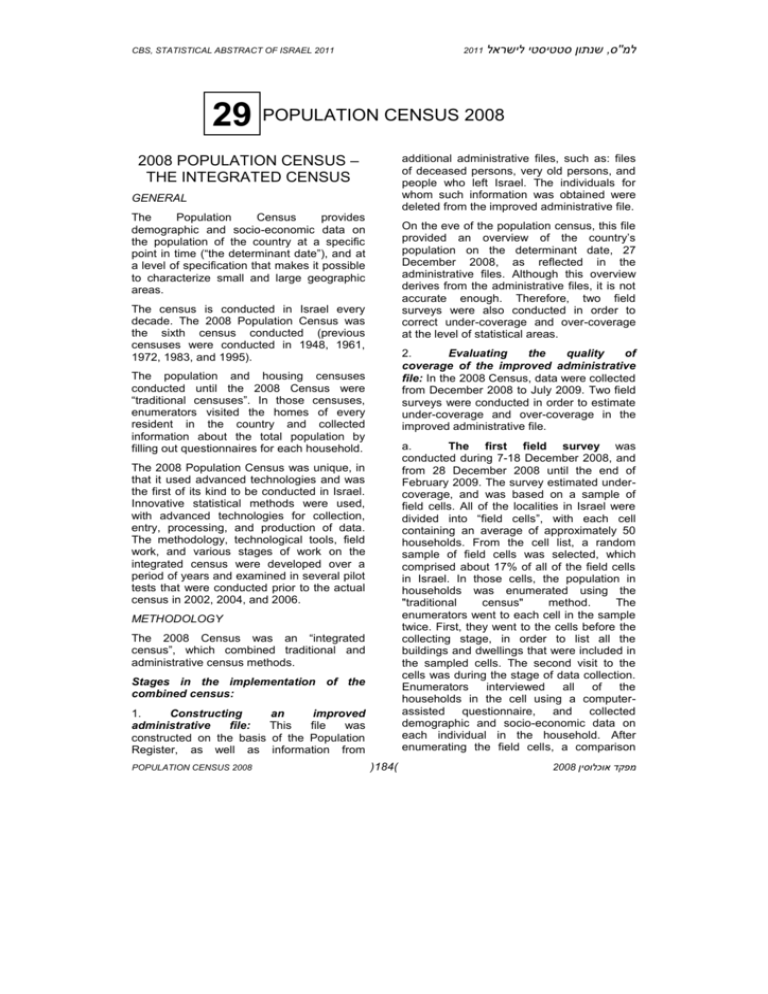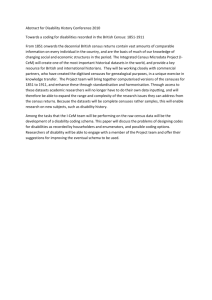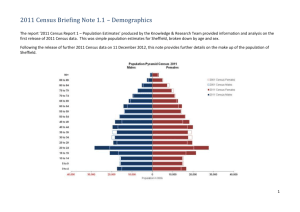COMMERCE AND HOTELS
advertisement

CBS, STATISTICAL ABSTRACT OF ISRAEL 2011 2011 שנתון סטטיסטי לישראל,למ''ס 29 POPULATION CENSUS 2008 2008 POPULATION CENSUS – THE INTEGRATED CENSUS additional administrative files, such as: files of deceased persons, very old persons, and people who left Israel. The individuals for whom such information was obtained were deleted from the improved administrative file. GENERAL The Population Census provides demographic and socio-economic data on the population of the country at a specific point in time (“the determinant date”), and at a level of specification that makes it possible to characterize small and large geographic areas. On the eve of the population census, this file provided an overview of the country’s population on the determinant date, 27 December 2008, as reflected in the administrative files. Although this overview derives from the administrative files, it is not accurate enough. Therefore, two field surveys were also conducted in order to correct under-coverage and over-coverage at the level of statistical areas. The census is conducted in Israel every decade. The 2008 Population Census was the sixth census conducted (previous censuses were conducted in 1948, 1961, 1972, 1983, and 1995). 2. Evaluating the quality of coverage of the improved administrative file: In the 2008 Census, data were collected from December 2008 to July 2009. Two field surveys were conducted in order to estimate under-coverage and over-coverage in the improved administrative file. The population and housing censuses conducted until the 2008 Census were “traditional censuses”. In those censuses, enumerators visited the homes of every resident in the country and collected information about the total population by filling out questionnaires for each household. a. The first field survey was conducted during 7-18 December 2008, and from 28 December 2008 until the end of February 2009. The survey estimated undercoverage, and was based on a sample of field cells. All of the localities in Israel were divided into “field cells”, with each cell containing an average of approximately 50 households. From the cell list, a random sample of field cells was selected, which comprised about 17% of all of the field cells in Israel. In those cells, the population in households was enumerated using the "traditional census" method. The enumerators went to each cell in the sample twice. First, they went to the cells before the collecting stage, in order to list all the buildings and dwellings that were included in the sampled cells. The second visit to the cells was during the stage of data collection. Enumerators interviewed all of the households in the cell using a computerassisted questionnaire, and collected demographic and socio-economic data on each individual in the household. After enumerating the field cells, a comparison The 2008 Population Census was unique, in that it used advanced technologies and was the first of its kind to be conducted in Israel. Innovative statistical methods were used, with advanced technologies for collection, entry, processing, and production of data. The methodology, technological tools, field work, and various stages of work on the integrated census were developed over a period of years and examined in several pilot tests that were conducted prior to the actual census in 2002, 2004, and 2006. METHODOLOGY The 2008 Census was an “integrated census”, which combined traditional and administrative census methods. Stages in the implementation of the combined census: 1. Constructing an improved administrative file: This file was constructed on the basis of the Population Register, as well as information from POPULATION CENSUS 2008 )184( 2008 מפקד אוכלוסין was made between two lists – the list of people registered in the improved administrative file, and the list of people enumerated in the field cells. For each statistical area (and for each locality that was not divided into statistical areas), two figures were obtained: the number of people listed in the improved administrative file, and the number of people enumerated in the field cells. Based on that information, the undercoverage of each statistical area (and each locality that was not divided into statistical areas) was estimated according to the relative proportion of persons who were enumerated in the field but who were not listed in the improved administrative file. (A statistical area is a geographical unit derived from the geographical-statistical division of urban localities numbering over 10,000 residents.) The demographic file: This file includes 100% of the population, with the addition of the demographic characteristics and weight assigned to each individual. The socio-economic file: This file includes households and individuals who were enumerated in the field (approximately 17% of the total population), and lists their demographic and socio-economic characteristics, with the addition of the weight assigned to each individual. The population census data, the census questionnaire, and additional information can be found on the CBS website. DEFINITIONS AND EXPLANATIONS Determinant date: The population census portrays the situation of the population at a given point in time, i.e. the determinant date. The determinant date in the 2008 Population Census was Saturday, 27 December, 2008. b. The second field survey was conducted from 25 March to the beginning of July 2009. The survey estimated overcoverage, and was based on a sample population derived from the improved administrative file. The individuals interviewed in the first field survey were eliminated from the second field survey. In the second field survey, telephone contact was established with individuals who had not been found in the sampled field cells in order to ascertain their address of residence. At the end of the second field survey, the rate of over-coverage was estimated for each statistical area (and for each locality that was not divided into statistical areas). This estimate was derived by calculating the relative proportion of persons listed in the statistical area (or locality) according to the improved administrative file, but who were not actually living there. Census population: The population that resided in Israel (including Israeli localities in the Judea and Samaria Area) on the determinant date, including residents of the country who were staying abroad on the determinant date and had been away from Israel for less than a year. The census population does not include: residents who had been staying abroad for a year or more on the determinant date; those who died before the determinant date; those who were born after the determinant date; and tourists and residents who were not Israeli citizens or did not have resident status – except those who were living in households with Israeli citizens on the determinant date, and those who had been living with Israeli residents for a year or more. Household: A group of persons living together in one dwelling, who have a common expense budget for food (i.e., who purchase food from one budget, pool of money, or source of income). 3. Revision of the improved administrative file and derivation of the census files: To express the balance of under-coverage and over-coverage in the improved administrative file, the weight that expresses the probability of that individual (and those represented by that individual) living at the address listed in the improved administrative file was calculated for each person. POPULATION, BY RELIGION, SEX AND AGE (Table 29.1) Religion: See the definition in the Introduction to Chapter 2 – Population. For the variables sex and age, there are no unknown values. To derive the 2008 census data, two files were prepared: POPULATION CENSUS 2008 )185( 2008 מפקד אוכלוסין Source of the data: The demographic file. Data include single residents of institutions. LOCATION OF WORK COMPARED TO LOCATION OF RESIDENCE, BY DISTRICT, SUB-DISTRICT, AND NATURAL REGION POPULATION AND HOUSEHOLDS IN LOCALITIES WITH 5,000 RESIDENTS AND OVER (Table 29.3) Location of work compared to location of residence: The data were calculated by comparing the locality of residence on the determinant date to the main locality of work during 2008. These data are calculated out of the total number of workers in 2008. (Table 29.2) Population: Age group: Persons aged 0-19 – the percentage of persons aged 0-14 and the percentage of persons aged 15-19 out of the total population. Aged 65 and over: Calculated as percentage of persons aged 65+, percentage of persons aged 75+, and percentage of persons aged 85+ out of total population. the the the the Households: Workers: Persons aged 15 and over, in one of the following groups: (a) Persons who worked for at least one hour during the week of the determinant date, or were absent from their workplace during the determinant week due to illness, vacation, etc.; (b) Persons who did not work during the week of the determinant date, but worked during the course of 2008. Number of persons per household: The relative percentage of households in a locality, by the number of persons living there. Source of the data: The socio-economic file. Data do not include single residents of institutions and those living outside of localities. Average number of persons per household: The ratio of the total number of persons to the total number of households in the locality. COMPARISON BETWEEN CENSUSES Source of the data: The demographic file. Data include single residents of institutions. (Table 29.4) The data are presented at the national level, according to the censuses conducted in: 1961, 1972, 1983, 1995, and 2008. Percentage of households with children up to age 17: The percentage of households that have at least one child aged 0-17, out of the total number of households in the locality. Percentage aged 65+: that have at of the total locality. The guideline in all population censuses is to maintain uniformity in all of the work processes, in order to create a stable basis for comparison of data over the years. At the same time, necessary changes that were made from one census to the next affect definitions of the population or of the topics to be investigated. of households with persons The percentage of households least one person aged 65+, out number of households in the The following are explanations of the methods for calculating the variables presented in the table: Source of the data: The socio-economic file. Data do not include single residents of institutions. POPULATION CENSUS 2008 )186( 1. Socio-economic data from the 1961 Census refer to persons aged 14 and over. In the rest of the censuses, socio-economic data refer to persons aged 15 and over. 2. Data from the 1961 Census were taken from various publications of the CBS. The data from the rest of the censuses presented in this table were re-calculated. 2008 מפקד אוכלוסין 3. The census weight was fixed in the 1961, 1972, 1983, and 1995 censuses, and equaled 5. In the 2008 Census, the census weight varied for different individuals. 4. In the 1983 and 1995 censuses, the accepted terminology for the variable “worked during the 12 months preceding the determinant date” was “employed in the annual civilian labour force”. 5. 6. persons aged 15 and over who worked at least one hour during the week of the determinant date; or who were absent from their workplace during the determinant week due to illness, vacation, etc.; or persons who did not work during the week of the determinant date, but worked during the 12 months preceding the determinant date; out of the total population aged 15 and over. Average number of persons per household: The ratio of the number of persons to the number of households. In the 1961 and 1972 censuses, the variable “worked during the 12 months preceding the determinant date” did not exist. Average number of persons per room: The ratio of the number of persons per household to the number of rooms for household use, for the total number of households. In the 1995 Census the variable “number of rooms for household use” was an aggregated value from “6 rooms and over”. Therefore, the data for the 1995 Census might be biased. In all of the censuses, the data presented on households do not include single residents of institutions, the population residing on kibbutzim, and the population residing outside of localities. Percentage of households with at least one car: The percentage of households that have at least one car, out of all households surveyed in the Census, who responded to the question “How many cars do you have?” Percentage of persons born abroad: In the 1961, 1972, and 1983 censuses, the percentage of persons born abroad was calculated only for the Jewish population; in the 1995 and 2008 censuses, it was calculated for Jews and others. Source of the data: Data on the total population, and data on the population aged 0-19, aged 65+, aged 85+, and born abroad were taken from the demographic file of the Census. Percentage of persons who did not study at all: The percentage of persons with zero years of schooling out of the total population aged 15 and over (the 1961 Census refers to the population aged 14 and over). The data on the percentage of persons who did not study at all, the percentage of persons with up to 8 years of schooling, the percentage of persons with an academic degree, the percentage of persons who worked during the 12 months preceding the determinant data, the total number of households, average number of persons per households, average number of persons per room, and percentage of households with at least one car were taken from the socioeconomic file of the Census. Percentage of persons with up to 8 years of schooling: The percentage of persons with 1-8 years of schooling out of the total population aged 15 and over (the 1961 Census refers to the population aged 14 and over). Percentage of persons holding an academic degree: The percentage of persons holding an academic degree (first, second, or third degree), out of the total population aged 15 and over. Worked during the 12 months preceding the determinant date: The percentage of POPULATION CENSUS 2008 )187( 2008 מפקד אוכלוסין SELECTED PUBLICATIONS PUBLICATIONS APPEARING ONLY ON THE CBS WEBSITE - Population Census - 2008 data POPULATION CENSUS 2008 )188( 2008 מפקד אוכלוסין






